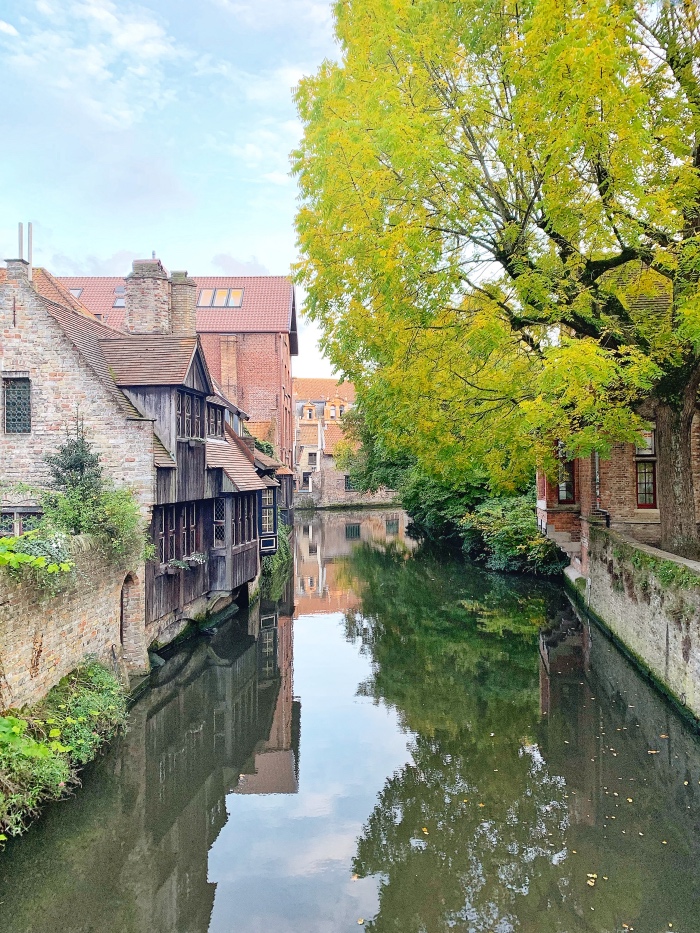
VAN EYCK AND THE ADORATION OF THE MYSTIC LAMB: MY TRIP TO FLANDERS TO DISCOVER A MASTERPIECE
The Adoration of the Mystic Lamb is the largest masterpiece by van Eyck but is also the most precious and delicate.
The painting is located in Belgium, more precisely in Flanders, a territory which is a treasure trove of treasures and masterpieces, about an hour by train from Brussel. That Flanders was a place full of art I’ve already understood last year, when I visit it for a tour to discover the Flemish painting, as I told you in the post Flemish painting: a tour among the masterpieces of Flanders. So, when I was invited to come back to Belgium for a trip following in the footsteps of van Eyck and his most important masterpiece I immediately accepted.
My trip to discover van Eyck and the Adoration of the Mystic Lamb
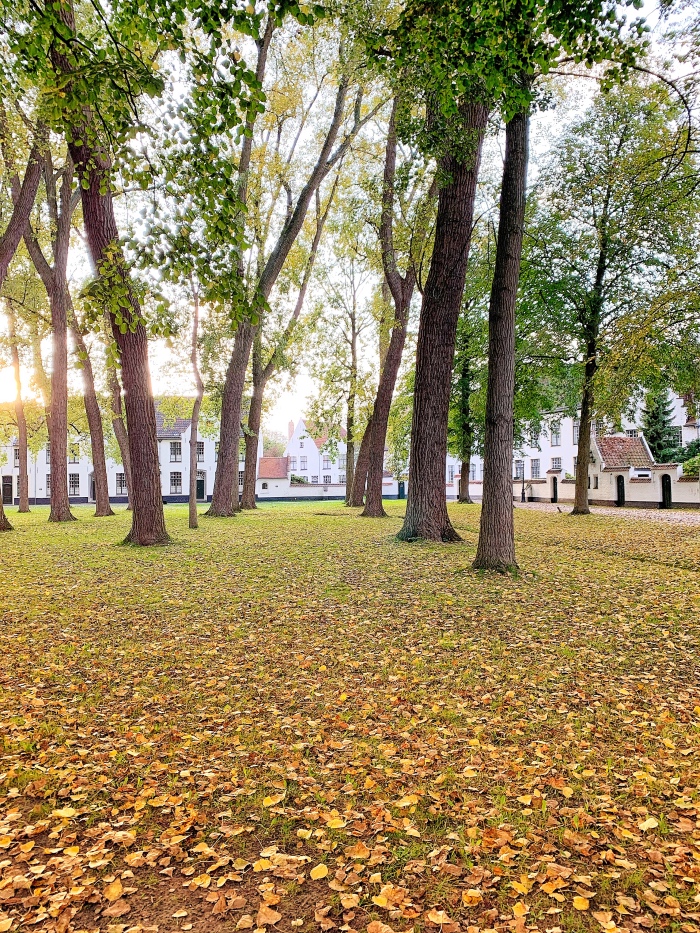
The Beguinage in Bruges
I received the invitation to come back to Flanders from VisitFlanders, which gave me the opportunity to admire the Adoration of the Mystic Lamb, the great masterpiece by van Eyck in Ghent, but only after a trip discovering the places where the artist lived, to find his traces in the two cities which connected their history with the story of his masterpieces: Bruges, the city where he lived, and Ghent the city where his masterpieces is housed.
For this reason my trip to Flanders, in the footsteps of van Eyck and to discover the Adoration of the Mystic Lamb starts from Bruges, the city where the artist lived and worked on his great masterpieces.
VAN EYCK IN BRUGES
DAY 1
The first leg of this trip starting from Bruges was the Markt, the large market square and the hotspot of the city, which at the time of van Eyck was a crossroads of wares coming from all over the world.
From here my walk continued among brick houses, bridges and canals up to the Beguinage, a complex of white painted houses surrounded by walls, founded at the time of the Crusades, which gathered independent and free women in this sort of protected quarter.
An example of women’s liberation which foreran the times of some centuries!
Immersed in an atmosphere of past times, I walked towards the Burg, the square where in the 15th century stood the church of Saint Donatian, the place where van Eyck was buried and housed “The Virgin and Child with Canon van der Paele” by van Eyck, today on display in the Groeninge Museum.
DAY 2
If Bruges of van Eyck was the capital city of international trade, where did bankers, traders and artists making works to decorate the residences of rich people in the early 15th century live? With this question my second day discovering art in Flanders and Bruges began.
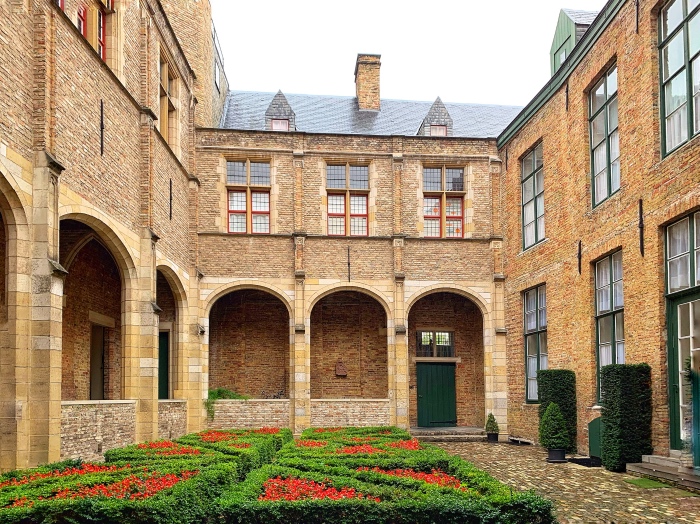
Bladelin Court in Bruges
I visited Bladelin Court, that is to say the residence of the Medici family in Bruges in the 16th century and located in the area of the city where the economical and trading centre of Bruges was. It was there that bankers and traders from all over Europe met and did business and here, in addition, first financial transactions of modern age were carried out and the Stock Exchange was born, which was named after the “van der Bourse” family who lived in Bruges.
So, I wasn’t surprised to find, few steps from the palaces where business was done and goods were exchanged, the quarter of the artist and the place where van Eyck’s House was located.
His house was certainly the residence of a wealthy man and, where now stands a brick wall, running along one of the many canals in Bruges, stood his house and the studio of the most important Flemish artist.
Jan van Eyck, it is worth remembering, was not only a great artist but also the court painter of Philip the Good, Duke of Burgundy, for whom he was also a diplomat and made several journeys.
Among the works van Eyck certainly painted in Bruges is the “The Virgin and Child with Canon van der Paele” housed in the Groeninge Museum in Bruges, and which is the largest painting made by the artist after the “Adoration of the Mystic Lamb”.
It was time to admire this painting so I went towards the museum!
In front of van Eyck’s painting it’s colours and details that captured my attention.
The scene is simple: Canon van der Paele, who commissioned the work, is presented by Saint Donatian and Saint George to the Virgin and Child.
The realism van Eyck can give the entire representation is, however, amazing. Each crease in fabrics, each wrinkle on Canon’s face and each imperfection in the skin are portrayed perfectly. Elements you can fully appreciate only when you are in front of his works and, in this case, by observing with close attention, you can see a reflection in the helm, in the elbow and in Saint George’s shield.
In this reflection you can see van Eyck’s self-portrait wearing his red turban while he is painting.
Wonderful!
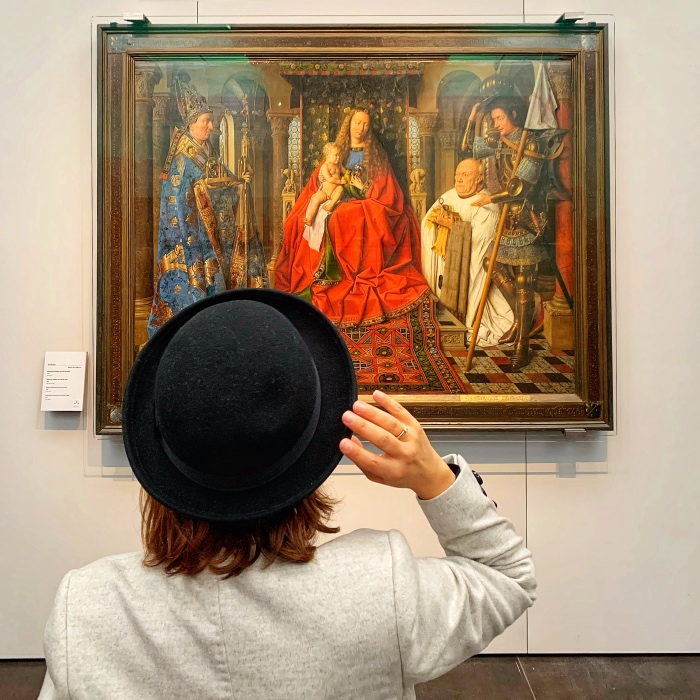
The Virgin and Child with Canon van der Paele by van Eyck
Before leaving Bruges I went to the Historium, a tourist attraction which will make you have an immersive experience in Bruges in 1437.
Through seven rooms you can retrace the story of Jacob, an imaginary apprentice of van Eyck, who has to help the artist complete “The Virgin and Child with Canon van der Paele”.
Among videos, reconstruction of rooms of the 15th century and special effects you will discover ordinary life of people in Bruges at the time of van Eyck.
So, after immersing myself in Bruges of the 15th century, it was time to admire the Adoration of the Mystic Lamb in Ghent.
DAY 3
Few kilometers from Bruges is the lively city of Ghent, housing the Adoration of the Mystic Lamb, considered van Eyck’s masterpiece.
My first leg was the SMAK of Ghent, the Museum of Fine Arts of the city, where the panels of the painting are currently undergoing a long restoration, which will end in 2020 when they will finally return home to the Saint Bavo Cathedral.
The laboratory is visible to the public and anyone can see restorers at work, who in the latest years have brought light and original colours of the painting of van Eyck and his brother Hubert to light.
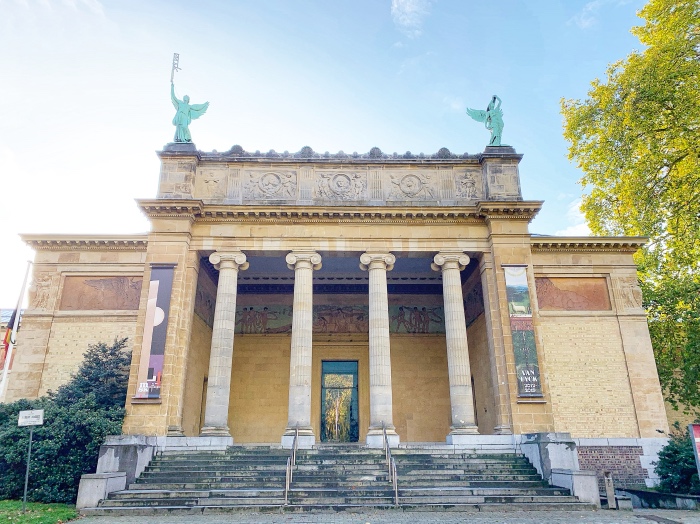
SMAK of Ghent
THE ADORATION OF THE MYSTIC LAMB
Considered van Eyck’s masterpiece, we have actually known since the 19th century that it was a painting the artist made together with his brother Hubert.
It was a restoration carried out in the 19th century, in fact, that brought an inscription that stated that the authors of the largest polyptych of the Flemish Renaissance were two brothers to light.
The Adoration of the Mystic Lamb was painted in 1432 for the Saint Bavo Cathedral.
It’s a work consisting of 12 wood oil painted panels, which portray in the inner part the subject of Redemption.
In the lower part is the Lamb, symbol of Christ, adored by a multitude of characters, including angels, saints and knights in the Garden of Eden. In the upper part, instead, around the figure of Christ the King with the Virgin Mary and John the Baptist are groups of angels singing and playing music, while in the outer panels are also the figures of Adam and Eve.
The outer panels depict Annunciation, saints, sibyls and also the commissioners kneeling: the noble landowner Jos Vijd and his wife Lysbette Borluut.
Bright colours, precise details, naturalism and the landscape in the background make this work an amazing masterpiece and which arouses many questions about who van Eyck really was, where he did his artistic training and which kind of studies he did.
This painting, more than any other masterpiece by van Eyck, proves how the artist had perfected the oil painting technique bringing it to highest level, but you can see also his skill at geometry, perspective and light effects, and his ability as a miniaturist which made him precise in portraying smallest details.
The life of van Eyck, especially as regards his life before arriving in Bruges, is shrouded in mystery, but the restoration of the Adoration of the Mystic Lamb shed light on many aspects of his work.
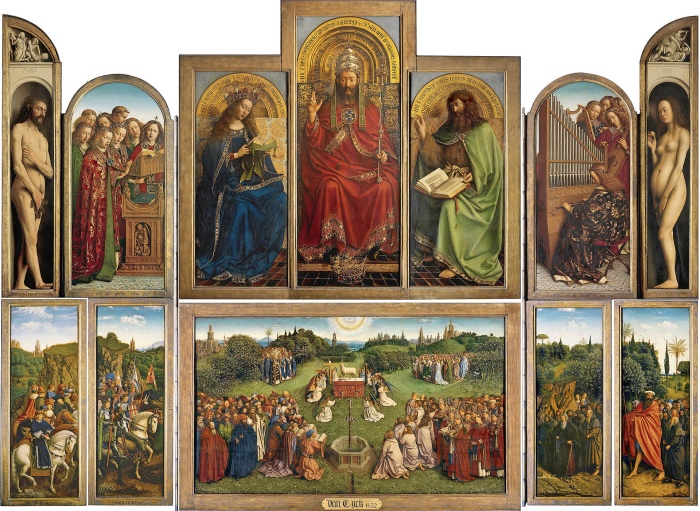
The Adoration of the Mystic Lamb in Ghent
In 2020 Flanders will celebrate van Eyck and the return home of the restored panels of the Adoration of the Mystic Lamb to the Saint Bavo Cathedral.
The first event of the year dedicated to van Eyck will be the exhibition “Van Eyck. An Optical Revolution” (from February 1st to April 30th 2020) at the Museum of Fine Arts of Ghent (SMAK): the greatest exhibition on van Eyck ever.
The exhibition will retrace van Eyck’s work and will reveal new aspects of his work, thanks to the display of the majority of his paintings and works of artists of his time; but visitors will also admire, at a close distance, the restored panels of the Adoration of the Mystic Lamb, before returning to the Cathedral.
The second event, instead, is the return home of the panels to the Saint Bavo Cathedral, in June 2020.
Also Bruges will celebrate van Eyck in 2020, by focusing on other aspects of his art.
In fact, the exhibition “Jan van Eyck in Bruges” (from March 12th to July 12th 2020) will be on at the Groeninge Museum.
And from April 14th to September 6th 2020, the exhibition “Memling now: Hans Memling in contemporary art” will be on view at St. John’s Hospital, to study in depth the art of Memling, to whom van Eyck passed ideally the baton.
This long post ends here with the description of a journey discovering a masterpiece and the artist who created it.
A trip that made me discover Flanders, a territory preserving an ancient atmosphere but able to give value to its treasures in order to pass them down to future generations.
If you want to discover Flanders of van Eyck you should make this trip, and for this reason I’ll give you some practical advice.
WHERE I ATE
In Bruges –> Lunch at Blackbird. Wonderful place and great attention to detail. But be careful: it is only open for breakfast and lunch.
In Bruges –> Dinner at Goesepitte 43. A very beautiful place where you can eat both meat and fish, and drink different wines recommended by the chef to best accompany the dishes.
In Bruges –> Café Vlissinghe. Atmosphere of old Bruges in this place I recommend. It’s one of the world’s most ancient pubs. Founded in 1515 is still working, without interruption up to the present day. In 2015 it celebrated its first 500th anniversary and the interior is made up of objects and furniture coming from past centuries. There’s also the armchair where, it is said, Charles V sat when he came here to drink.
I didn’t eat here but I wished I could have time to sit and taste a soup, whose scent fills the place!
In Ghent–> Lunch at Mémé Gusta. Traditional Flemish dishes in a beautiful place and where to eat is a pleasure. Their stew is divine!
In Ghent–> Dinner at Pakhuis. This place is enormous. Located inside an old factory and transformed into a charming restaurant. I had raw fish but the restaurant offers meat, too.
WHERE I SLEPT
In Bruges –> Hotel Portinari. Only 1 kilometer from the railway station, is near all main places I visited and restaurant where I ate.
In Ghent–> Best Western Hotel Chamade. Few minutes from the railway station and located just in front of the tram stop. The historic centre of the city is easy to reach.
READ ALSO – Jan van Eyck’s works: 5 things to know

